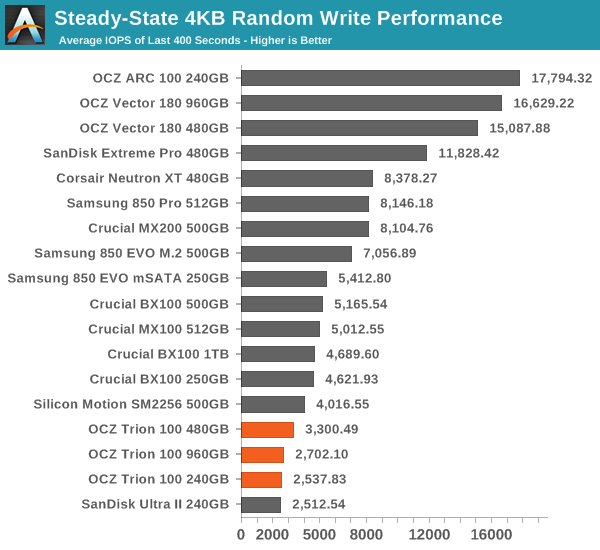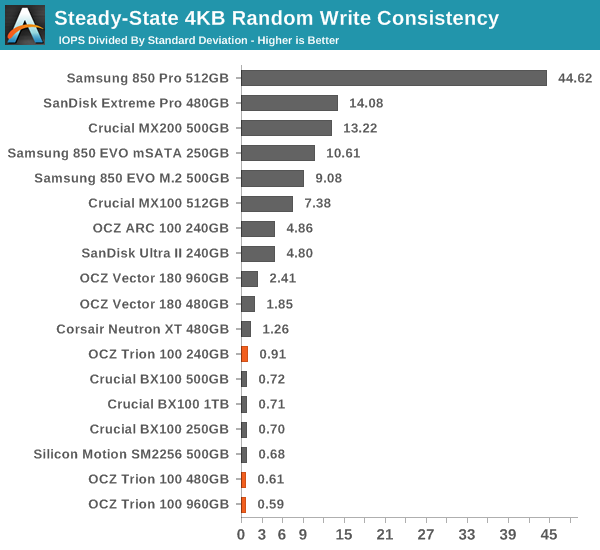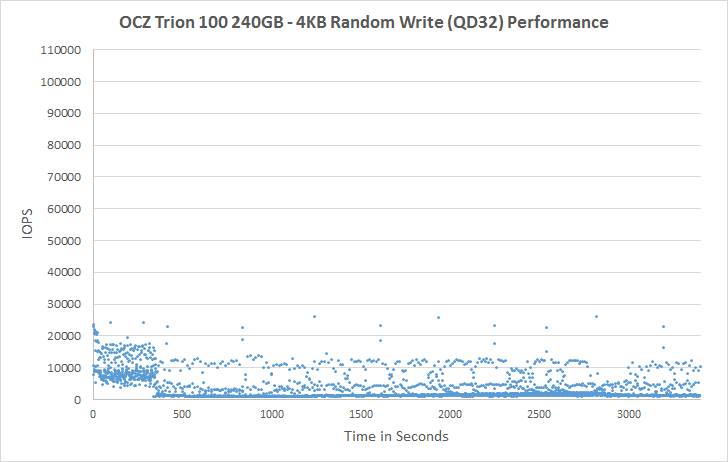OCZ Trion 100 (240GB, 480GB & 960GB) SSD Review: Bringing Toshiba to the Retail
by Kristian Vättö on July 9, 2015 12:01 PM ESTPerformance Consistency
We've been looking at performance consistency since the Intel SSD DC S3700 review in late 2012 and it has become one of the cornerstones of our SSD reviews. Back in the days many SSD vendors were only focusing on high peak performance, which unfortunately came at the cost of sustained performance. In other words, the drives would push high IOPS in certain synthetic scenarios to provide nice marketing numbers, but as soon as you pushed the drive for more than a few minutes you could easily run into hiccups caused by poor performance consistency.
Once we started exploring IO consistency, nearly all SSD manufacturers made a move to improve consistency and for the 2015 suite, I haven't made any significant changes to the methodology we use to test IO consistency. The biggest change is the move from VDBench to Iometer 1.1.0 as the benchmarking software and I've also extended the test from 2000 seconds to a full hour to ensure that all drives hit steady-state during the test.
For better readability, I now provide bar graphs with the first one being an average IOPS of the last 400 seconds and the second graph displaying the standard deviation during the same period. Average IOPS provides a quick look into overall performance, but it can easily hide bad consistency, so looking at standard deviation is necessary for a complete look into consistency.
I'm still providing the same scatter graphs too, of course. However, I decided to dump the logarithmic graphs and go linear-only since logarithmic graphs aren't as accurate and can be hard to interpret for those who aren't familiar with them. I provide two graphs: one that includes the whole duration of the test and another that focuses on the last 400 seconds of the test to get a better scope into steady-state performance.

TLC SSDs in general don't perform well under sustained random workloads and the Trion 100 is no exception. It seems that with TLC SSDs we have to accept a drop from 5K to 2-3K IOPS, which is still fine for basic client workloads since most SSDs from 3-4 years ago couldn't even match that.

The consistency isn't great either, but it's not particularly poor either when compared agains Silicon Motion drives.
 |
|||||||||
| Default | |||||||||
| 25% Over-Provisioning | |||||||||
Looking at the performance over time, we can see that the baseline performance hovers at about 1,000 IOPS with frequent peaks occuring at 5K to 10K IOPS. That's actually very similar to the Neutron XT's (Phison S10) graph because the baseline is also 1,000 IOPS, although the peaks are higher and more frequent, but it further reassures that the underlying firmware architecture is similar. Increasing over-provisioning doesn't increase the baseline performance, but it does make peak performance moments more frequent and higher (from 10K IOPS to 25K IOPS).
 |
|||||||||
| Default | |||||||||
| 25% Over-Provisioning | |||||||||










65 Comments
View All Comments
ncsaephanh - Thursday, July 9, 2015 - link
"It's just silly to take up to 50% hit in performance and only offer a few dollar savings because any educated buyer will gladly pay the extra few dollars for a substantially better drive."Exactly, and enthusiasts are usually the ones recommending products to other more casual users/buyers.
LB-ID - Thursday, July 9, 2015 - link
Doesn't matter if it comes with gold-plating and platinum trim. It's still an OCZ, and they're the worst company in the SSD marketplace. They went broke for a reason, should've just let the company die peacefully. Toshiba is a good company, I hope they don't get dragged down to OCZ's level.Gigaplex - Thursday, July 9, 2015 - link
It's not an OCZ, it's a Toshiba with OCZ branding.serndipity - Thursday, July 9, 2015 - link
Three years later and this is what's being offered!!!!!From the OCZ earning conference call om May 1, 2012.
"And further it’s our intent to continue to bring low cost technologies to market such as our TLC-based products, enabling this trend."
The recent move into 1x nm lithography has been problematic for both MLC and TLC.
Until others catch up with Samsung's V-NAND, it's only SSD I'm putting into builds now.
ssdpro - Thursday, July 9, 2015 - link
Others catch up with V-NAND? Who the heck cares what they brand the NAND... 3D nand is a joke. There is no such thing as NAND that exists in the 2nd dimension lol. Plus, with Samsung you constantly have to deal with firmware update failures and crippled performance after 6 months. OCZ isn't great but they are disconnected from reality.Gigaplex - Friday, July 10, 2015 - link
Except V-NAND isn't just branding. There are multiple layers of NAND stacked on top of each other for much higher density. And as far as I'm aware, the only performance degradation issues have been with the 840 and 840 EVO series. Neither uses V-NAND, they're conventional TLC.masterpine - Thursday, July 9, 2015 - link
In the past year I've deployed 30 SSD's at the company I work at. We use them for crunching cloud scanner data, so we're regularly filling then clearing entire 500gb drives and hitting them pretty hard while working with the datasets. 20 of those drives are Samsung 850 Evo's, they've all been running fine for about a year now. 4 of them are Crucial M550's, had one of them fail within a week but the RMA replacement drive is going well and all 4 are trucking along fine 6 months later.The other 6 were OCZ Arc 100's. All 6 failed within two months. RMA'd them all, assumed a bad batch. Serials on the replacement drives were two months newer, two of the 6 failed again within a couple of weeks. I've relegated the rest of the OCZ drives to unimportant tasks, it's just not worth the risk. I had high hopes after the Toshiba acquisition but it would take something extraordinary from me to trust an OCZ product again.
zodiacfml - Friday, July 10, 2015 - link
Then Samsung's V-NAND is actually working and no company could touch or get near that technology including Intel/Micron. Samsung is on fire, as I am also impressed with their 14nm SoC in the S6.StrangerGuy - Thursday, July 9, 2015 - link
OCZ is such a toxic brand I wonder why Toshiba is daft enough to still keep it.FXi - Thursday, July 9, 2015 - link
So sad we can't get an update to the Intel 730 (735?) with 960GB size. Specifically NOT pci-e so a wider set of systems can use them. Clearly there are memory chips to do such a thing as shown here today...